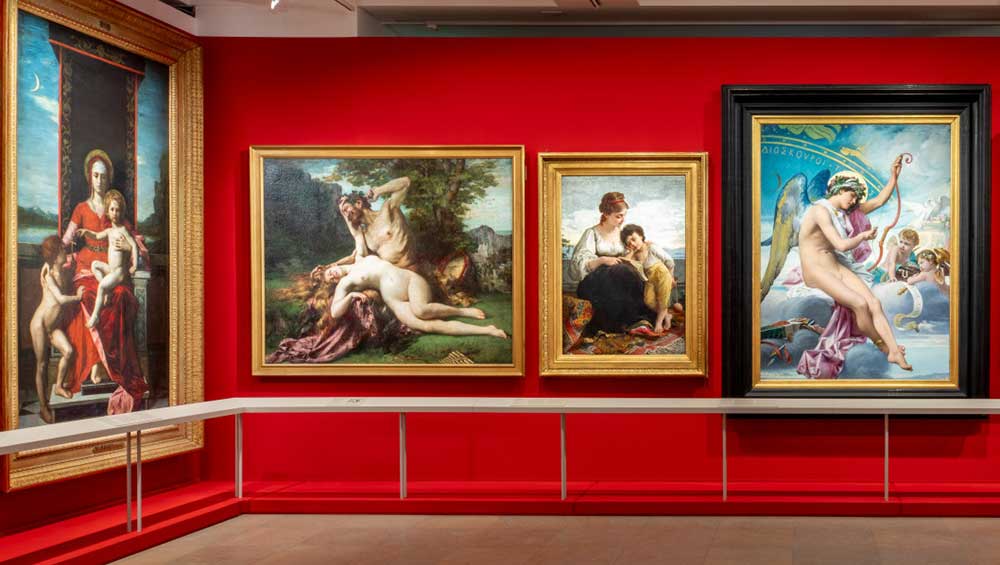
Installation view, Paris 1874: Inventing Impressionism, Musée D’Orsay, Paris 2024. Photo: Sophie Crépy - Musée D’Orsay.
Musée D’Orsay, Paris
26 March – 14 July 2024
by JULIET RIX
This glorious, extensive and inventive exhibition (which includes a remarkable virtual element) celebrates the 150th anniversary of the first impressionist exhibition. Or, more accurately, the first exhibition in which impressionists-to-be showed their work together. It was, in fact, the inaugural show of the self-styled Société Anonyme, the “Anonymous Society of Painters, Sculptors, Print-makers etc”, which included seven of the now most famous impressionists, and – with the help of a scathing review by a Paris art critic – gave the style its name.
What drove the soon-to-be-impressionists, as well as the 24 other artists exhibiting in this seminal show, was not, in fact, shared style, subject matter, or working practices. It was a desire to have more control over their careers and sales, breaking free from the dominance of the Paris Salon, which had for a couple of centuries defined and monopolised artistic success in France.
The seven spring 1874 exhibitors whose fame justifies this flagship anniversary exhibition are Claude Monet (1840-1926), Edgar Degas (1834-1917), Auguste Renoir (1841-1919), Camille Pissarro (1830-1903), Paul Cézanne (1839-1906), Alfred Sisley (1839-99), and – the only woman – Berthe Morisot (1841-95). A little more established than the others, and determined to make it at the Salon, Édouard Manet (1832-83) declined to take part. But he did lend a painting from 1873 by his soon-to-be sister-in-law Morisot, Cache-Cache (Hide and Seek), one of her most engaging works merging landscape and intimate genre.
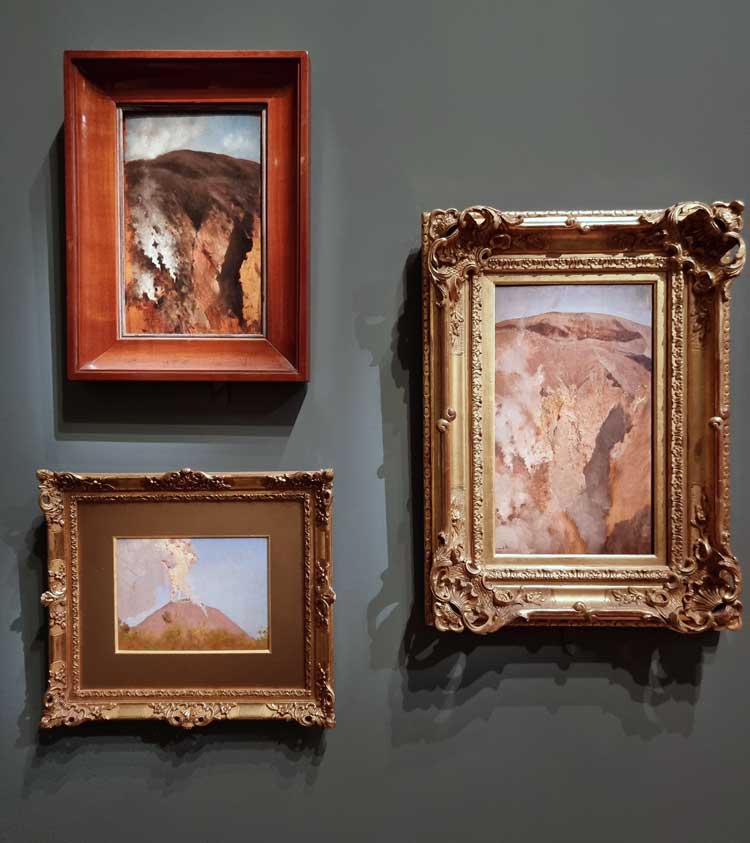
Giuseppe de Nittis, paintings of Vesuvius. Installation view, Paris 1874: Inventing Impressionism, Musée D’Orsay, Paris 2024. Photo: Juliet Rix.
Among the 24 other artists exhibiting were some with undoubted impressionist leanings – such as Giuseppe de Nittis who, invited by Degas, exhibited a trio of tiny glowing oils of Vesuvius, all present at the Musée d’Orsay – as well as some who were anything but impressionist. Auguste-Louis-Marie Ottin (1811-90), for instance, was a highly academic sculptor, and his bust of Ingres (1867-68) is accomplished but entirely mainstream. Despite the conventionality of his art, Ottin was a militant socialist and former Communard, and for him the independent exhibition was less an artistic statement than a political one.
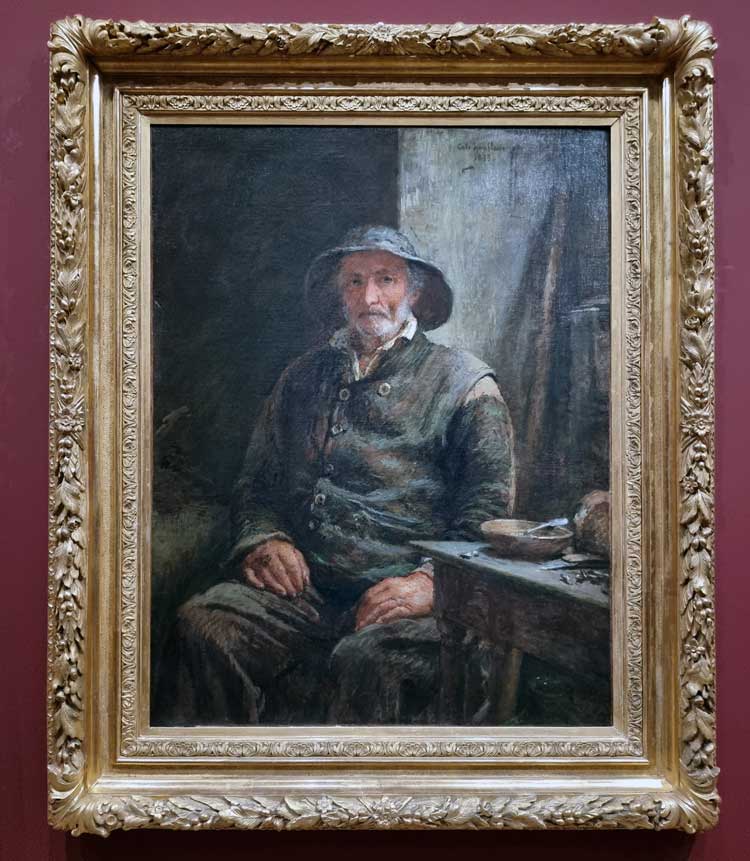
Adolphe Félix Cals. Le Vieux Pêcheur, The Old Fisherman, 1873. Installation view, Paris 1874: Inventing Impressionism, Musée D’Orsay, Paris 2024. Photo: Juliet Rix.
The oldest member of the group, Adolphe Félix Cals (1810-80), who exhibited a number of realistic genre paintings (represented here by Le Vieux Pêcheur, The Old Fisherman, 1873), joined the group and the show because of his conviction that, “there is one thing can save our art, and that is the rigorous application of the principles of liberty”.
Liberty was a topical issue. Paris was just emerging from the Franco-Prussian war of 1870 and the violent civil strife of the Paris Commune, and the Musée D’Orsay exhibition starts by setting the scene with a couple of visceral lithographs by Manet, La Barricade (1871) and Guerre Civile (Civil War, 1871). During this period of conflict, some of the Anonymous Society artists had fled to London, others had fought and one, Frédéric Bazille (1841-1870), had been killed. The group’s earlier plans for an independent exhibition had inevitably been put on hold, but by 1873 their damaged city was being rapidly reconstructed – physically and socially – and they were looking to the future once more.
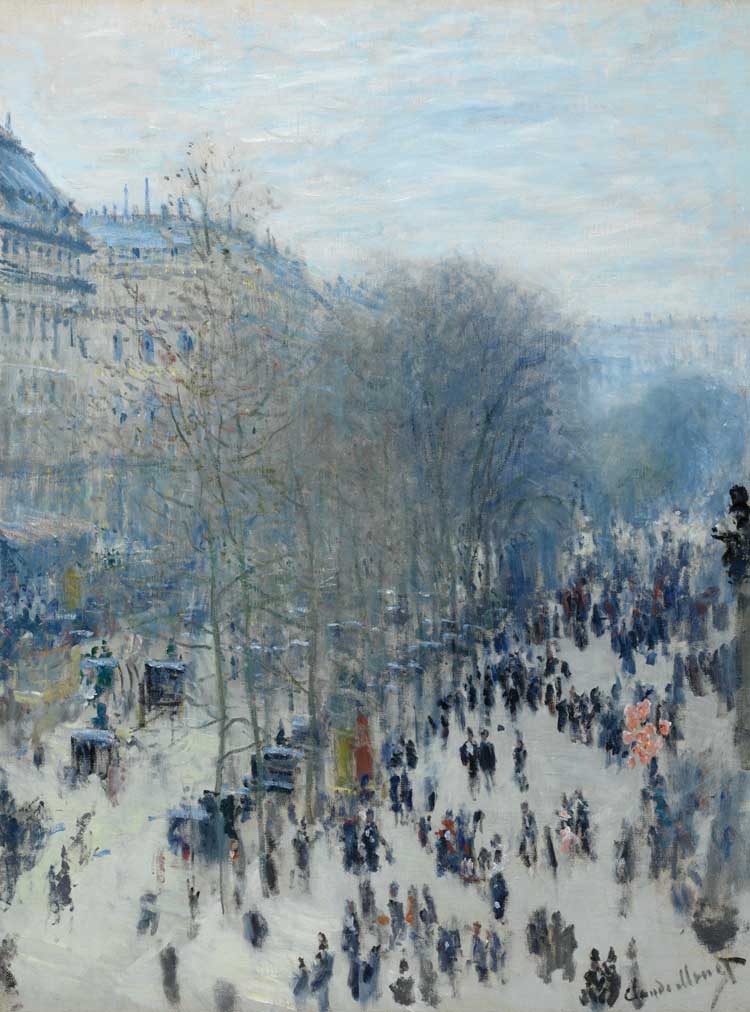
Claude Monet. Boulevard des Capucines, 1873-74. Oil on canvas, 80.3 × 60.3 cm. Nelson-Atkins Museum of Art, Kansas City. Image courtesy Nelson - Atkins Media Services.
Degas found the group a venue for their delayed exhibition, the former studio of photographer Félix Nadar (1820-1910), right in the heart of “new” Paris. Grand avenues, planned under Napoleon III and designed by Georges-Eugène (Baron) Haussmann (1809-91), which still dominate central Paris today, were taking shape all around, and the newly completed Opéra was a few hundred metres away. The studio occupied the upper floors of 35 Boulevard des Capucines, on a broad thoroughfare that bustles now as it did when Monet painted it, looking down from the balcony of No 35, for the exhibition.
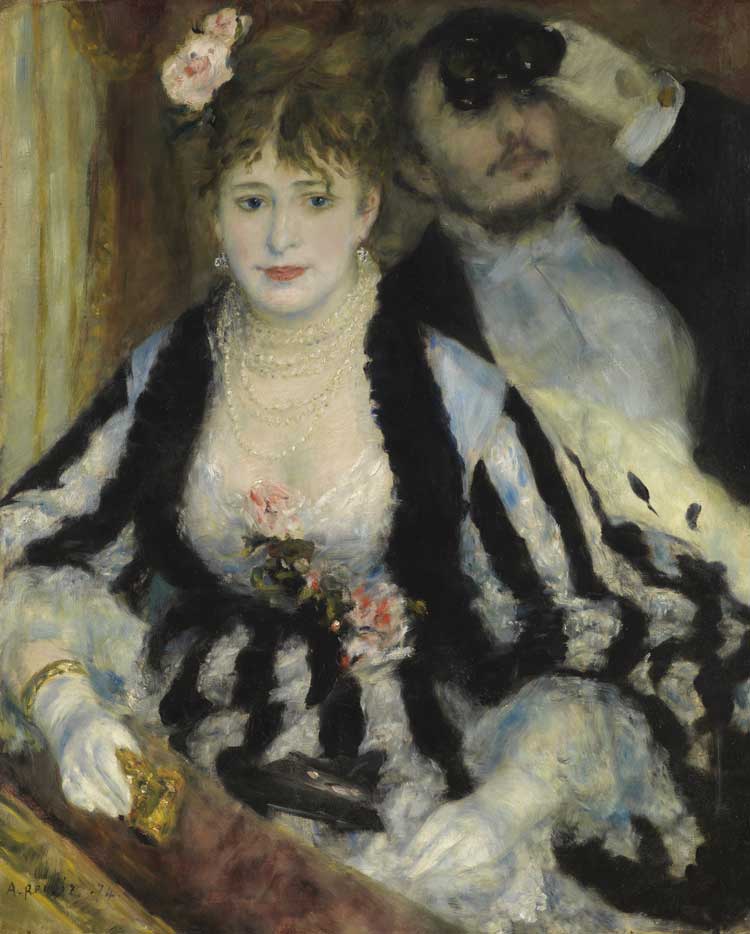
Auguste Renoir. La Loge, 1874. Oil on canvas, 80 × 63.5 cm. The Courtauld (Samuel Courtauld Trust), London. Photo © The Courtauld/Bridgeman Images.
This impressionist work hangs today, as then, alongside other scenes of modern life (a favourite subject of the impressionists) including Renoir’s closeup of an elegant society couple at the theatre, La Loge (The Theatre Box, 1874), actually posed by Renoir’s brother and a young Montmartre woman. Here, too, is Degas’ deliberately informal composition of dancers rehearsing at the new Opéra, Répétition d’un Ballet sur la Scène (The Ballet Rehearsal Onstage, 1874) and his Aux Courses en Province (At the Races in the Countryside, c1869). Though not especially impressionist in technique, this latter picture takes a marvellously momentary angle on a scene of contemporary society and, if you look closely, in the carriage a wet nurse has just finished breastfeeding the baby of Degas’ race-going bourgeois friends.
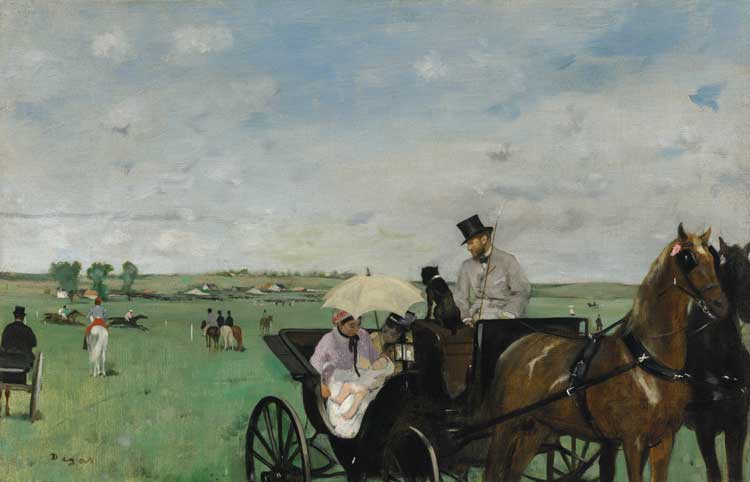
Edgar Degas. Aux Courses en Province (At the Races in the Countryside), c1869. Oil on canvas, 36.5 x 55.9 cm. Boston, Museum of Fine Arts, Boston. Photo © 2024 Museum of Fine Arts, Boston.
Cézanne showed “modern scenes” in 1874 too; some technically conventional hunting scenes, but also Une Moderne Olympia, Esquisse (A Modern Olympia, Sketch, 1873-74) which was met with incredulity and disgust. It revisits Manet’s Olympia, which itself scandalised the 1866 Salon due to the direct gaze of the nude Olympia and the association of that name with prostitutes. Cézanne added insult to injury by including a male client, and by exhibiting a roughly textured oil sketch rather than a smoothly finished painting.
The 200 or so works in the independent 1874 show were all chosen by the artists themselves, unlike the Salon’s 4,000 items which were selected by a jury who accepted or – as was more often the case for the Anonymous group’s art – rejected submitted works. The Salon perpetuated a largely conventional academic hierarchy of taste and acclaim that placed polished “history painting” at its peak. The current show gives us a taste of this context, dedicating a sizeable room to the Salon of 1874, which opened a couple of weeks after the Anonymous show just a 20-minute walk away on the Champs-Élysées.

Jean-Léon Gérôme. L’Eminence Grise, 1873. Oil on canvas, 68.6 x 101 cm. Museum of Fine Arts, Boston. Bequest of Susan Cornelia Warren. Photo © 2024 Museum of Fine Arts, Boston.
There is some high-quality painting here, but the vast majority is clearly “Salon style”, with lots of religious, historical and mythological content presented with clean lines and glossy finish. One of the most striking works is L’Eminence Grise (1873) by Jean-Léon Gérôme (1824-1904), depicting Capuchin friar Père Joseph, adviser to Cardinal Richelieu, amid vibrantly colourful bowing courtiers. It won the Salon’s gold medal before complaints emerged that, by making the image so small, he was turning history painting into mere genre. These critics wished publicly that the medal had gone to the elderly Jean-Baptiste-Camille Corot (1796-1875), whose unoriginal pastoral landscape La Danse des Bergères, Souvenir d’Arleux (The Dance of the Shepherdesses, 1871) hangs just above. Stung, Gérôme handed back the medal.
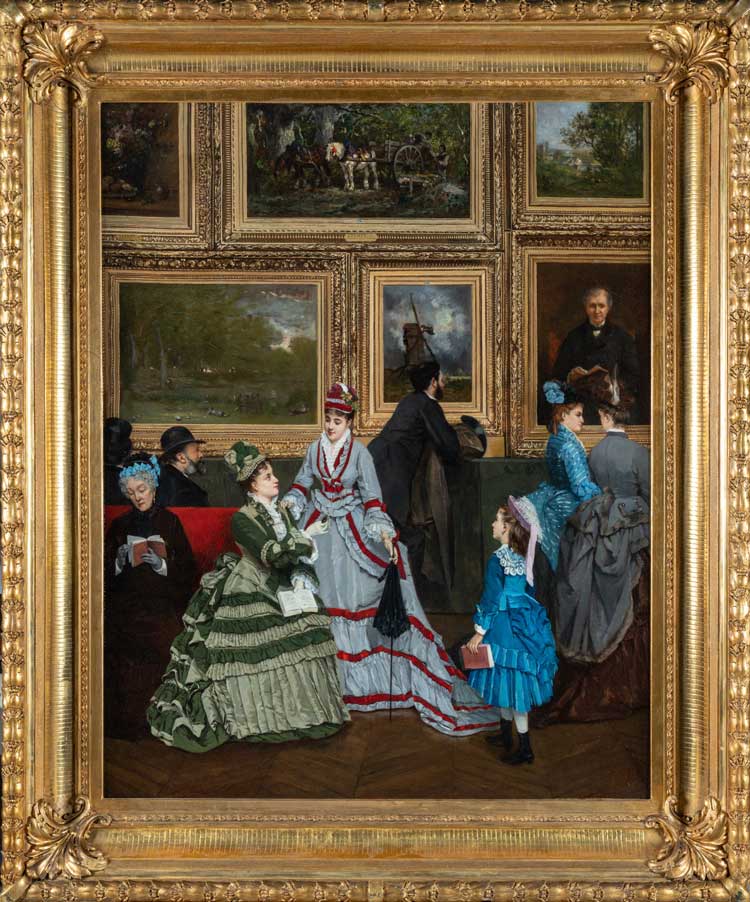
Camille Cabaillot-Lassalle. Le Salon de 1874. Oil on canvas, 100 x 81.5 cm. Musée d’Orsay, Paris. © Musée d’Orsay, dist. RMN-Grand Palais / Sophie Crépy.
Some lighter commentary did get past the Salon gatekeepers. The delightful Le Salon de 1874, painted by Camille Cabaillot-Lassalle (1839-1902) and six other artists, is an amusing oil that includes a wall of that year’s salon with miniature versions of six paintings all painted by their original creators (hence the six additional artists). Beneath the miniature paintings, the picture shows exhibition-goers – the women dressed in the height of fashion – too busy posing and chatting to bother with the art.
There were grey areas around the edges of Salon acceptability, and it was not necessarily a binary choice to submit to the Salon or the Anonymous exhibition; 12 artists had work in both. De Nittis’s Dans Les Blés (In the Wheat, 1873), for instance, was shown at the Salon. Quite an impressionist painting, it is nonetheless pretty and unchallenging.
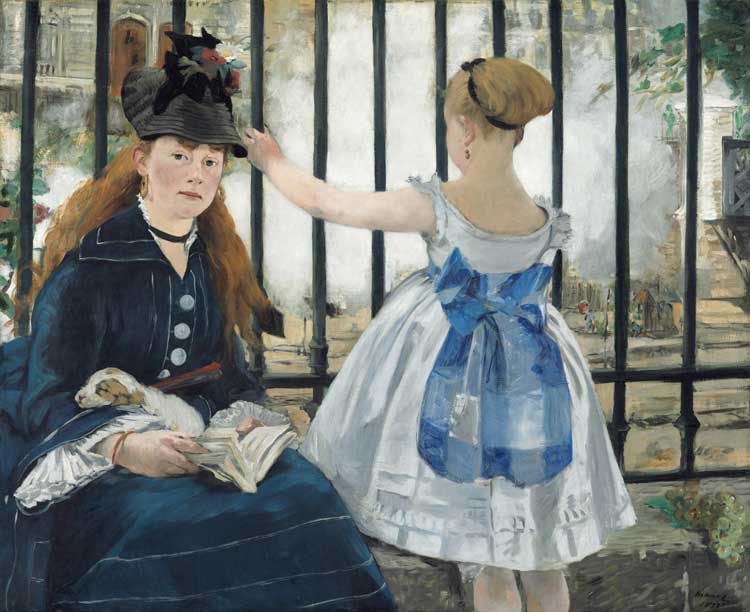
Édouard Manet. Le Chemin de fer, 1873. Oil on canvas, 93.3 x 111.5 cm. The National Gallery of Art, Washington.
© Photo Courtesy of National Gallery of Art, Washington.
The Musée D’Orsay has intriguingly paired works by the same artist accepted and rejected by the Salon. Manet’s Le Chemin de Fer (The Railway, 1873) – in which a woman and child are shown by a railing behind which steam billows from a train – made it into the Salon. The composition and characters are uncontroversial and the impressionist element remains largely in the background. His Le Bal de l’Opéra (The Opera Ball, 1873), however, was rejected. Moral judgment may have played a part since the image was understood to show transactions between prostitutes and clients. But artistically, too, he was pushing the boundaries with a composition that crowds out of the frame and shows a pair of pink boots peeping into the scene from a balcony above.
While most of the impressionists (or impressionists-to-be) focused on people in social and society settings, Degas exhibited La Repasseuse (The Laundress/Woman Ironing, 1869), a deceptively simple pastel that directly communicates the repetitiveness of the woman’s work through the angle of her arm. This contrasts tellingly with the nearby Blanchisseuse de Lin (Laundress, 1874) by Jules Émile Saintin (1829-94), a superficially charming but coquettish image that ignores the work of Paris’s laundresses in favour of feeding the stereotype of their “availability”, which appealed to high society men. This polished painting was shown at the Salon. Looking at it, one can hardly be surprised that Morisot showed only at the independent exhibition – where she was highly regarded by her peers – despite the fact that she stuck largely to traditionally “feminine” subjects. All 10 of her paintings at the 1874 show depicted women and children.
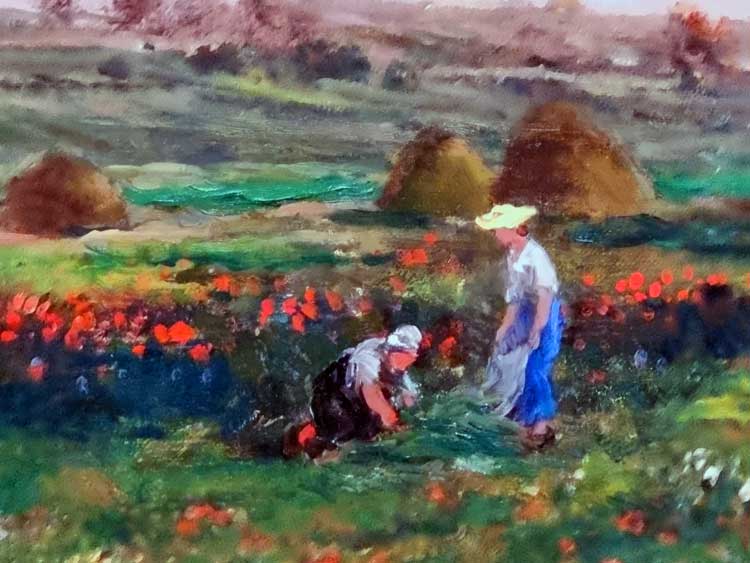
Charles-François Daubigny. Les Champs au Mois de Juin (Fields in the Month of June), 1874 (detail). Installation view, Paris 1874: Inventing Impressionism, Musée D’Orsay, Paris 2024. Photo: Juliet Rix.
The Musée D’Orsay’s Plein Air room is particularly interesting, making it apparent that landscape painting had been moving towards impressionism long before the impressionists. Charles-François Daubigny (1817-78) – an established artist who is thought to have influenced Monet, Pissarro and Sisley – had for well over a decade been calling some of his landscape paintings “impressions”. The reason is clear from his Les Champs au Mois de Juin (Fields in the Month of June, 1874), a glorious expanse of poppies which, despite its impressionist elements, made it into the 1874 Salon.
By the 1870s, some of the impressionists-to-be were already taking the approach further, as we see from Pissarro’s glistening Gelée Blanche (White Frost, 1873), in which the “white” frozen ground is made up of a multiplicity of colours, and the air is visibly chill. At the 1874 exhibition, Pissarro priced this painting at a very ambitious 2,500 francs. It didn’t sell, but it shows the value the artist placed on it.
Paris critic Louis Leroy, however, was not impressed: “Are these furrows, is this frost? … These are but palette scratches … on a dirty canvas.” He was equally mocking of Monet’s glowing view of sunrise over Le Havre, Impression: Soleil Levant (1872), appropriately the centrepiece of the next room. Monet later recounted his response when asked for a title for this work: “It could not really pass for a view of Le Havre; I answered ‘put impression’.” This is the most quintessentially impressionist piece from the 1874 show – a fleeting moment, play of light at its heart, a scene with modern industry in the background and watery nature to the fore, a feeling as much as a representation. Leroy picked up the term “impression”, deriding the paintings of Monet, Sisley and Pissarro as “impressionist”. The label stuck – eventually – and three years later the artists were applying it to themselves.
Their spring exhibition of 1877 has perhaps an even greater claim than 1874 to be “the first impressionist exhibition”. Certainly, it was the first – and only – one so titled and involved only 18 artists, with a far greater homogeneity of style and interest. The last room of the current exhibition is dedicated to this spring 1877 flowering of impressionism as we know it.
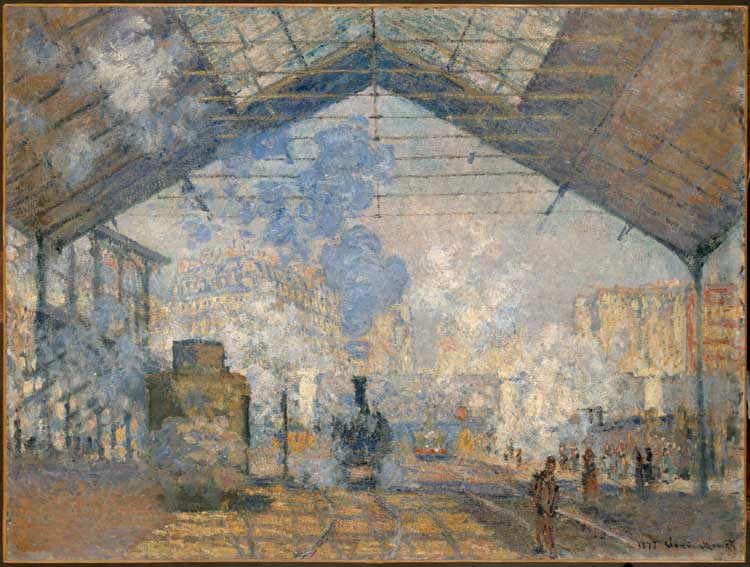
Claude Monet. La Gare Saint-Lazare, 1877. Oil on canvas, 75 x 105 cm. Musée d'Orsay, Paris. © RMN-Grand Palais (Musée d’Orsay) / Hervé Lewandowski.
Monet dominates with a remarkable range of paintings, from his atmospheric La Gare Saint-Lazare (1877, precursor to his station series), to his unusual Un Coin d’Appartement (A Corner of the Apartment, 1875) of a boy in a Paris flat flanked by exotic plants, and a slightly bizarre painting of turkeys in front of the chateau of the commissioning patron, Les Dindons (décoration non terminée), 1877. His chosen subtitle, “unfinished decoration”, was likely a provocative potshot at the critics labelling impressionist works unfinished and merely “decorative”.
Confidently asserting the impressionist agenda, too, was Renoir. Echoing his La Loge at the start of this show, we have Bal du Moulin de la Galette (Dance at the Moulin de la Galette, 1876) depicting a crowded afternoon of pleasure at this contemporary Montmartre venue. On a scale usually then reserved for “serious” history painting, it drew a great deal of attention, negative and positive. It was bought by Gustave Caillebotte, a wealthy new member of the group who had helped fund the exhibition (a couple of his paintings hang nearby) and declared by Émile Zola to be, “the capital piece” of the 1877 exhibition.
Here we leave the impressionists firmly set on their course to global fame. But that isn’t the end of the Musée D’Orsay’s anniversary offering. Along the former railway station hall of the museum, is a remarkable virtual extension of the show – a fun and fascinating 45-minute experience during which, headsets on and briefed, we walk through the impressionists’ world of 1874. In a work of considerable technical achievement, we wander along Boulevard des Capucines and stand with the artists as they discuss their work. They are a little cartoonish and in the English version have strong American accents, but these are minor issues.
-Excurio.jpg)
Boulevard des Capucines. Virtual reality. Concept art © Excurio - GEDEON Experiences - musée d'Orsay.
We are transported to the 1874 Salon, its high walls crammed with art, and accompany some of the artists as they paint en plein air. The summer scene on the island of Grenouillère is particularly enjoyable, with couples dancing and swimmers splashing around us. The highlight, though, is, of course, attending the 1874 Anonymous exhibition itself, seeing the pictures just viewed in today’s gallery “hung” on the dark red walls of Nadar’s studio as they were in 1874 – or as accurately as two years’ research could establish. No photos of the show survive, but there is a catalogue and a variety of written descriptions. It is an intriguing and memorable addition to be taken on a virtual journey back 150 years to “be there” at the first exhibition of the impressionists.
• The exhibition, under the title Paris 1874: The Impressionist Moment, will be at the National Gallery of Art, Washington DC, from 8 September 2024 to 19 January 2025.